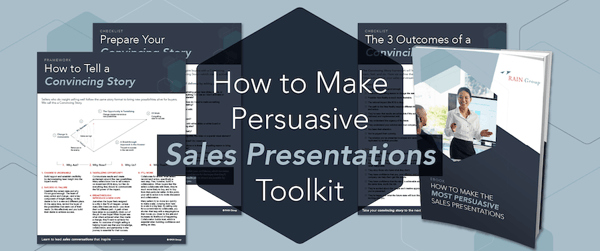You can be spot-on building rapport with your buyers and uncovering their needs, but without communicating the impact of what you’re selling, you—and your initiative—won’t be a priority.
When you’re able to understand and articulate the impact of your solutions, you can help buyers start thinking differently.
Buyers need the ROI case to justify purchase decisions, but they don't get it from sellers. In fact, according to buyers, only 16% of sellers are very effective at it.
When you’re able to answer the “so what?” question, you demonstrate and quantify the impact your solution will have on buyers.
Here's an example:
You: If we implement this program, how much do you think it would affect your staff turnover?
Buyer: Well, all in all, it probably would improve by 10%.
You: OK. Given your staff size, that means you’d decrease unwanted turnover by about 70 people each year, right?
Buyer: Yes, I agree. That’s about right.
You: And we established earlier that to rehire, retrain, and recoup from lost productivity, each individual person who is unwanted turnover costs you about $150,000.
Buyer: Wow! That’s over $10 million if we can do it.
It’s not always this simple to get the buyer to determine the specific impact, but creating an impact model can help you convince them of the benefits of taking a particular action.
What's an impact model?
Your impact model is a set of assumptions about how buying from you will financially benefit the buyer. It’s based on buyer-specific business factors and how your solutions can improve them.
As a seller, you need to understand the various factors that determine the impact of your offering if you want to build an ROI case for a buyer and communicate it to them.
What's the Value of an Impact Model?
A strong ROI case starts with knowing the financial calculus of a buyer’s situation. In the previous scenario, the buyer knew there was a financial impact to hiring, training, and recouping lost productivity.
If you know the potential impact of common needs, you can ask specific questions to determine the impact for each buyer.
Common business factors that affect financial impact—some with linear financial cases and some not—include:
- Time to market
- Profitability
- Waste
- Cost in any area while maintaining or improving quality
- Salesperson performance
- Brand recognition or preference
- Employee productivity
Each one of these areas (and many more not listed here) can be quantified.
How to Build an Impact Model
Creating an impact model involves a combination of buyer collaboration and an understanding of the impact of your solutions. Your efforts should be customized to each buyer; if you make a generic or poorly constructed ROI pitch, it can lose you the sale.
These five steps give you a roadmap to create a thorough and credible impact model.
1. Mapping
The first step to creating an impact model is to map out:
- The problems you solve
- The products, services, and approaches you solve them with
- The impact of solving those problems
If you don’t know the exact impact of solving the problem, you need to understand the factors that affect how to calculate the impact.
It’s a good idea to do a practice run. On a piece of paper, create three columns and write out:
- Common buyer needs
- Products and services that solve those needs
- The financial and emotional impact of solving those needs
2. Ask Specific Questions
Incisive questions enable you to identify the factors that are most important to buyers. This is one reason collaboration is so important—they may be able to fill in gaps and provide critical context.
Knowing what to ask and when can make a difference when building your impact model. You’ll want to:
- Ask financial questions to make your ROI calculation
- Ask questions to uncover the non-financial and emotional impacts of a solution
- Ask what won’t happen, so you can uncover the risks and negative impacts of not moving forward.
3. Collaborate with Your Buyer
In our experience, sellers don't customize their pitches to make the ROI case for specific buyers. In fact, they don't even attempt it.
What’s the best way to build to a plausible and believable ROI case? Do it collaboratively with the buyer.
When you build ROI for the buyer, they don't own it and they’re not invested in it. But when you do it together, the buyer is invested and they're more likely to see that the ROI can be reasonably achieved.
Read: How to Build Rapport in Sales >>
4. Demonstrate Impact Visually
It’s one thing to tell a buyer about the impact a purchase will make on their business.
It’s quite another to show them. After all, being able to visualize change is an important part of realizing it and moving forward with the sales process.
It can be easy to get lost in the numbers. While you need information to make your ROI case believable, don’t overshare.
Instead, pull the most important and relevant information and present it in an easy-to-explain, visually appealing way. Think graphics, not spreadsheets.
You may be able to do this on your own, or you might need to get help from your marketing or sales enablement teams to create imagery. But the idea is to show the ROI visually so buyers can see the difference between their present reality and their projected one.
5. Develop Your Case
Now that you have a solid grasp on the financial impact of your solution, it’s important to build your case further. After all, you’re not just trying to convince the buyer to move forward—you’re trying to get them to do so with you.
One of the best ways to do this is by building credibility. Use case studies and stories to demonstrate similar impact and reinforce the belief that you can deliver on your promises. If you have current or past clients who are willing to speak on your behalf, getting them on the phone with high-value prospects is a great way to further build trust in your ability to do what you say you can.
Despite the financial focus of an impact model, impact is emotional as well. You’re not just selling a solution with financial benefits; you’re selling the ability to get more done, relax more, or earn that promotion. Often, people make decisions based on emotional factors and justify with hard facts.
If the buyer needs more, don’t be afraid to try more methods. Charts, calculators, graphs, images, and tables can all illustrate the before and after of your solution. The stronger you can make your case, the more likely you’ll close your sale.
Go Beyond the ROI Case
Sellers need to understand that factors that change the context of each sale. If you can quantify these factors and collaborate with the buyer to help them understand the impact, you’ll demonstrate the financial benefits of closing a sale with you.
The most persuasive presentations are conversations, not one-way pitches. In our How to Make Persuasive Sales Presentations Toolkit, we share resources and frameworks for leading impactful conversations at any stage of the sales cycle. Download now. >>







